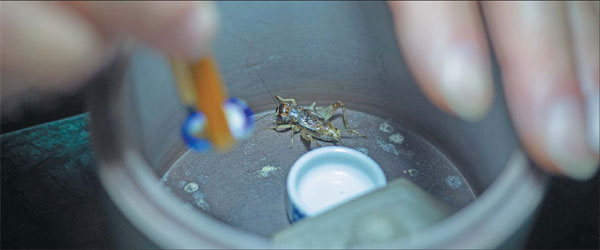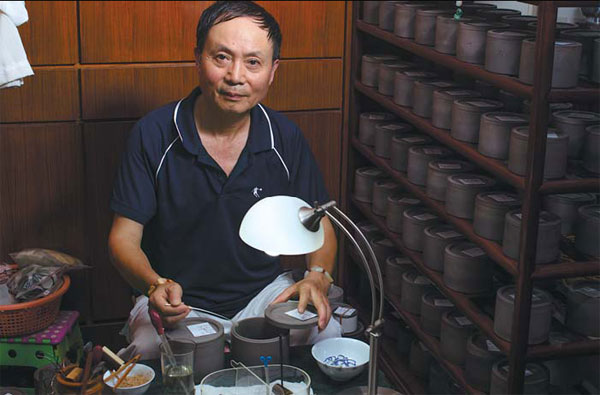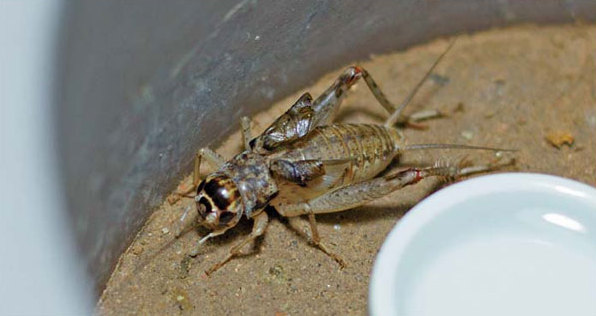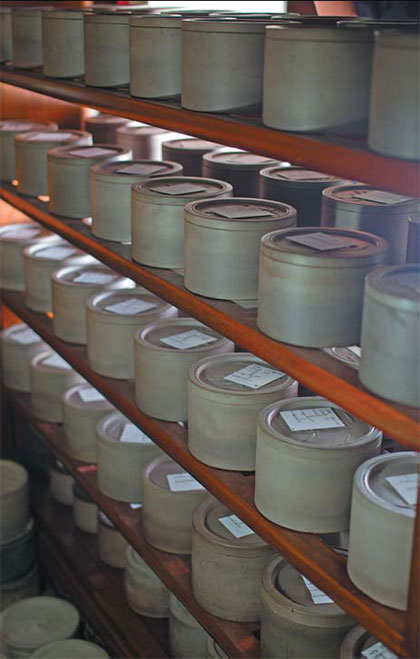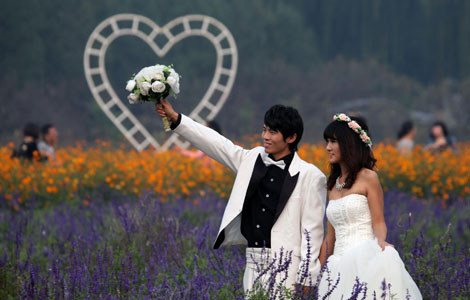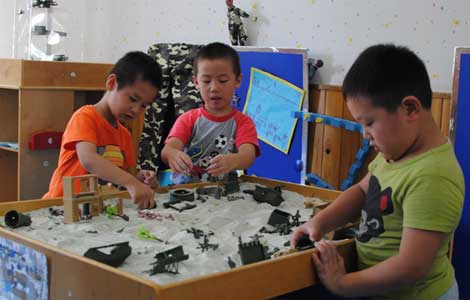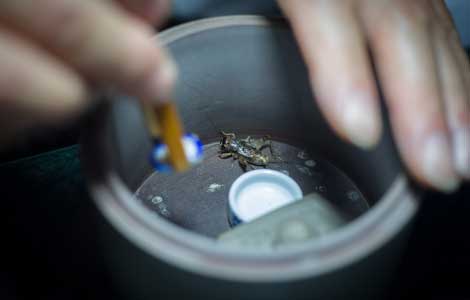Classic clash of the crickets
Updated: 2013-10-07 07:26
By Xu Junqian in Shanghai (China Daily)
|
||||||||
Battling bugs no small passion for fans, patrons and purveyors
It's two weeks to go before plucky Purple Golden Wing jumps into the arena for his once-in-a-lifetime fight.
To prepare, the promising gladiator is shifting from his staple diet of corn, wheat and rice to a more carnivorous fare of shrimp, goat liver and snake meat to "get fully charged" for the fight, said his trainer and patron.
Purple Golden Wing is a cricket, a species of the purple kind, the most aggressive among the six common types.
|
Trainer Gu Haifang carefully feeds a fighting cricket in his cramped Shanghai apartment. One of eight selected to battle in the city's cricket tournament, the gladiator has been fed a special diet to get fully prepared. Photos by Gao Erqiang |
|
Gu Haifang, who started the hobby more than 50 years ago, blames urbanization and pollution for difficulties in finding a good specimen today. |
|
A cricket caught on Shanghai's Chongming Island has molted eight times, which owner Gu said is rare. |
|
Gu has more than 100 crickets that each live in a clay pot in his home. He spends at least five hours a day caring for them. |

For the past two months he and another 100 or so crickets have been carefully looked after by retired property manager Gu Haifang in a corner of his cramped apartment in Shanghai.
Purple Golden Wing is one of the few - eight to be exact - of the elite class selected from a hundred candidates found in fields of Henan province by the 63-year-old cricket master as he sought a champion to battle in the city's final fight of the year in October.
The contest Gu and Purple Golden Wing entered, a cricket fighting competition in Lyuhua town in Chongming county, is one of the largest in town, if not the country.
Interest in authentic Chinese pastimes, rather than hobbies such as golf or karaoke, is on the rebound. Cricket fighting, a tradition cultivated by emperors in the Tang Dynasty (618-907) and revived over the past two decades, is making a comeback.
"It's a very 'intelligentsia' game, but at the same time masculine enough," said Gu, who first embraced the hobby at the age of seven in the alleys of his hometown under the guidance of his father.
The self-described "thrifty diehard" spends 10,000 yuan ($1,634) or so every year on his passion. Money aside, it takes him at least five hours a day to feed, bathe and examine his 100-plus warriors, even dropping females one-by-one into their "bedrooms" every night to "cheer them up". He separates them in the morning.
"My wife complains that I am like having a hundred babies every year at this season," he said.
But he doesn't find it eccentric because the "craze is very common among (his) many cricket friends".
At several flower and bird markets in the metropolis - where a variety of plants, birds and even pet insects are sold - small crickets priced from 10 to thousands of yuan each have occupied the most conspicuous place at almost every stall since August.
Some vendors have even transformed their entire space into cricket stores.
"Four to five hundred (crickets) can be sold in a day in good times like weekends," said Liu Hang, a stallholder at Wanshang flower and bird market, the largest of its kind in the city. He has been in the cricket trade for nearly a decade.
"Business has been going up every year and buyers are very generous with these small creatures, although they live only three months," he added.
Crickets are often disposed of or released into the wild after the fighting season ends in late November.
According to the Shanghai Evening Post, hundreds of thousands of crickets are sold from a single flower and bird market in Shanghai every year.
An estimated 100,000 cricket connoisseurs in the city, the largest group in the country, might spend a billion yuan a year on their hobby, buying amenities ranging from nail-size ceramic water feeders to mini bamboo buckets for taking the insects outdoors.
"It's a game every boy grows up with in Shanghai, like the Barbie dolls for girls. Rich or poor, you can always enjoy it," said He Wen, a 39-year-old Shanghai native who founded the first website in China about cricket fighting, xishuai001.com.
"You can either catch a cricket from your back yard or squander tens of thousands of yuan on a breed believed to be invincible. But they do not necessarily win," He said.
The younger generation born in the 1970s and '80s who are fond of the game are more than ready to spend, though less acquainted with the pastime than older practitioners.
He told China Daily that he spends 50,000 yuan every year on his hobby and has also invested 100,000 yuan in the website since it was founded in 2003 as "a non-profit platform for cricket lovers all over the country to share information and passion".
There are about 70,000 registered members of the website, 70 percent of them below the age of 40, according to He. They meet in person no more than twice every year, mainly to fight their coddled crickets, but online discussions such as where to catch the fieriest fighters or what kind diet is more likely to produce a winner are underway daily.
Contests of all size and level range from one-to-one street fights to official tournaments organized by government, especially after the autumn equinox, a time when crickets are believed to have stored enough energy and are strong enough to fight.
Organized by the Qibao township government, the Jiuxing Cup tournament attracted more than 100 contenders and another hundreds in the audience in September. This year's champion took home 12,000 yuan.
"Our bottom line is no gambling is involved. If there is anything we don't want to pass on from our ancestors about the game, it's the gamble part, which seriously vulgarizes the otherwise genteel game and makes it notorious," said Gu, who is one of the organizers.
Gambling on cricket fighting is illegal in China. But "black market" cricket fighting involving gambling is common, said Gu. The high stakes drive up the price of a good specimen.
The system for cricket fighting is complex and methodical, strictly following the rules from ancient times. Tips to raise a winner are usually passed by word of mouth between fathers and sons. Some of them are even turned into folk adages to help remember.
"Those who chirp loudest fight hardest" is one that teaches green hands how to pick a winner.
Liu, the cricket seller, claimed that his specimens mostly come from Shandong province, where the environment breeds a particularly aggressive type. They are handled by middlemen who bring them to major cities for sale.
But senior players like Gu prefer to venture into the remote country themselves, sleeping by day and catching crickets at night in cornfields with the aid of a flashlight.
In Yanjin, Henan province, an entire village is dedicated to the business of catching crickets during the season. It offers services including bed and breakfast and "guides to cricket searching".
"It's getting ever-harder to find a good specimen, so we have to travel further and further," said Gu, blaming urbanization and pollution as the two main cricket killers. He mourns "the old days when a good one could be easily found outside the city walls".
"In the past, an average cricket could fight for at least seven rounds, but now three rounds are enough to exhaust most contenders," he said.
Enthusiasm for the game has also pushed up the price of cricket jars as an investment like antique vases and paintings.
Experts believe the most precious existing clay pots date back to the Ming Dynasty (1368-1644). At an art auction in 2004 in Xiamen, Fujian province, a blue-and-white Ming porcelain cricket pot fetched 2 million yuan.
For some aficionados - well aware of the saying that the insects are kept for one autumn, while the pot for a whole life - lavish tens of thousands of yuan on a vessel handmade by "masters" in Suzhou, Jiangsu province. It shows the prestige of both the bugs and their patrons.
"The price (of the pot) has been escalating, just like our houses," said an insect peddler surnamed Xue at the flower and bird market in Shanghai. He said two years ago, he invested 3,000 yuan on a jar he found at a fair in Suzhou and has since been offered twice the price for the palm-sized pot.
Is it all worth it?
"You have to do something to pass the time living in your apartment," said Xue.
xujunqian@chinadaily.com.cn
(China Daily USA 10/07/2013 page7)
Most Viewed
Editor's Picks

|
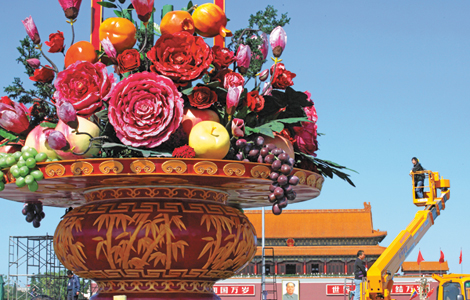
|

|

|

|

|
Today's Top News
Academics evaluate China at conference
Experts examine core values of China, US
China needs to export ‘public goods’: expert
Sowing the seeds of new business
Chinese investors visit Silicon Valley
Two Chinese die in plane crash near Saipan
Destroying Syria's gas arms started
Direction charted to resolve disputes
US Weekly

|

|
